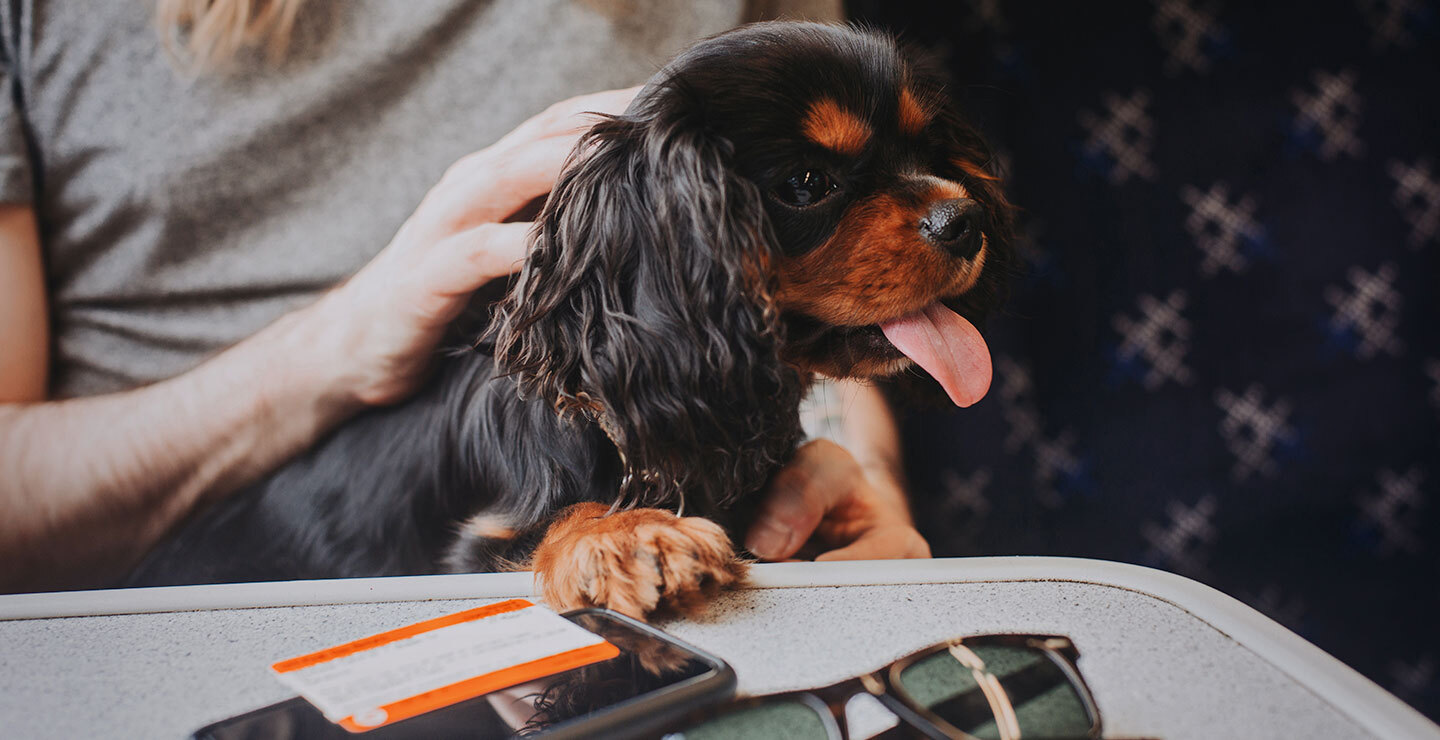Dogs can travel on the train with you for free, as long as they don’t annoy other passengers or endanger them. Each passenger is allowed a maximum of two dogs, but you’ll have to keep them on a lead or in a pet carrier.
If you plan to bring more than two animals with you, you’ll have to check with the Train Operating Company responsible for your service as you may be required to pay a fee. And if they might do it at home, your pets aren’t allowed to climb on the seats. They’re for paying passengers only!
What are the rules for bringing dogs on board?
We’re sure your furry friends will be on their best behaviour, but here’s a quick summary of what’s expected of them.
As per the National Rail Conditions of Travel, the following rules apply when you travel with your dog(s):
- Each passenger can take two dogs or other small domestic animals for free
- Dogs must be kept on a lead for the duration of the journey (including the station) unless they’re in a pet carrier
- Pet carriers can be a maximum of 85 x 60 x 60cm
- Dogs are not allowed on seats – they’re for passengers!
- If your dog causes a ‘nuisance or inconvenience’ to other travellers, you may be asked to leave the train with your animal
- Dogs and other pets aren’t allowed in dining/restaurant carriages (with the exception of assistance dogs)
Are dogs allowed in First Class?
Dogs are on the whole welcome in First Class, as long as they’re on a lead and behave well!
Technically speaking, Train Operating Companies do reserve the right to refuse entry to any animal, except for guide dogs, who are allowed on all modes of transport by law. However, as long as your pooch is well-behaved, you won’t have any problems!
When will I have to pay for my dog?
Each passenger has a free allowance of two dogs. Additional pets beyond the free allowance may be subject to a charge of up to 50% of a full adult fare, with a maximum charge of £5.00 for a single journey and £10.00 for a return. Most of the major TOCs observe this policy, including LNER, Avanti West Coast, GWR and Greater Anglia.
Taking other pets on the train
You’re welcome to bring cats and other domestic animals with you.
Dogs aren’t the only animals allowed on trains – you can bring up to two small domestic animals (such as cats) with you on board. However, they must be kept in a pet carrier at all times. The rules as stated above apply in equal measure to animals other than dogs; they’re not allowed on seats, must be well-behaved and cannot enter dining/restaurant carriages.
Livestock and other non-domesticated animals are not allowed to travel on trains.
Dogs on the Eurostar
Registered guide and assistance dogs are the only animals allowed on Eurostar services. They must have been trained by an organisation affiliated to one of the following:
- Assistance Dogs (UK)
- The International Guide Dog Federation
- Assistance Dogs International
Assistance dogs travel for free, but they’ll need the necessary paperwork to cross international borders.
Dogs on sleeper services
The Night Riviera (to Cornwall) and Caledonian Sleeper (to Scotland) have different policies on dogs.
- Night Riviera: dogs are allowed on board at no extra cost, but they must travel in the guard’s van in a pet carrier. They are not allowed into sleeper cabins.
- Caledonian Sleeper: dogs can travel with you in a sleeper cabin. You don’t have to buy a ticket for them, but a cleaning charge of £30 for the room will apply.
Image: "57603 Night Riviera from Paddington to Penzance" by Train Photos is licensed by CC BY-SA 2.0
Tips for travelling with dogs
Handy advice to ensure your pooch travels comfortably and safely.
Train travel can be intimidating for dogs – all the new smells, sounds and people they’ll encounter can be overwhelming. Here are a few things you can do to make their (and your) lives easier!
Give them a gentle introduction
Arrive a bit early to allow your dog to get used to the station. Once they’re at ease with the ticket hall, move on to the ticket barriers and the platform. If you can, try taking them on a few quiet journeys before attempting to travel on a busy rush-hour service.
Reward good behaviour
Give positive reinforcement to your dog when they look at ease and follow commands, like “sit” and “settle”. You can do that with treats or strokes – the aim is to reward calm behaviour.
Recognise when they’re uncomfortable
Keep an eye out for behaviours that suggest your dog is uncomfortable. These include excessive panting, lip licking, excessive pacing, chewing the lead, tucking their tail between their legs and whining. Remember – behaviours that might seem normal in some contexts (like drooling before dinner) might signal anxiety when on the train; if you think your dog is uncomfortable, don’t be afraid to get off the train. It’ll be for the best!
For more information, have a look at the excellent guides by Dogs Trust and Blue Cross on travelling with your dog.

